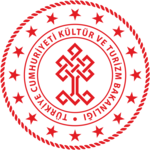Ethnography Museum of Ankara

The Ethnography Museum of Ankara is a museum of ethnography dedicated to the cultures of Turkic civilizations. The building was designed by architect Arif Hikmet Koyunoğlu and was built between 1925 and 1928.[1] The museum temporarily hosted the sarcophagus of Mustafa Kemal Atatürk from November 21, 1938 until November 10, 1953, during the period of the construction of Anıtkabir, its final resting place.
Temporary resting place of Atatürk

Following Atatürk's death on November 10, 1938 at Dolmabahçe Palace, Istanbul, his remains were transferred on November 19 by sea on the battlecruiser TCG Yavûz[2] to Izmit and subsequently by train[3] to Ankara, arriving on November 20.[4] The casket was placed on a catafalque in the front of the Turkish Grand National Assembly building for Atatürk's state funeral.[5] On November 21, 1938, his body was transported on a horse-drawn caisson to the Ethnography Museum of Ankara. British,[6] Iranian[7] and Yugoslavian[8] guards of honor escorted the cortège to the museum.
Atatürk's mahogany casket was placed inside a white marble sarcophagus where it remained for nearly 15 years. On November 4, 1953, after the completion of Anıtkabır, his sarcophagus was opened in the presence of Parliament speaker Refik Koraltan, Prime Minister Adnan Menderes, Chief of General Staff Nuri Yamut and other officials. The casket was removed and placed on a catafalque in the museum, where it remained until November 10, 1953 on the 15th anniversary of his death. It was transferred to Anıtkabir on the same day, escorted by military honors on a caisson in a cortège.[9]
See also
External links
- Almost 60 pictures of pieces as well as shots of the museum's interior and exterior
- Museum official website
References
- ^ Turkish Architecture Museum Database: Arif Hikmet Koyunoğlu Archived 2011-07-27 at the Wayback Machine
- ^ "Yavuz zırhlısının güvertesinde (19 Kasım 1938)" (in Turkish). K-Atatürk. Archived from the original on 2012-09-03. Retrieved 2011-04-17.
{{cite web}}: Unknown parameter|deadurl=ignored (|url-status=suggested) (help) - ^ "İzmit'te trene verilirken (19 Kasım 1938)" (in Turkish). K-Atatürk. Archived from the original on 2013-01-26. Retrieved 2011-04-17.
{{cite web}}: Unknown parameter|deadurl=ignored (|url-status=suggested) (help) - ^ "Ankara'ya varışı (20 Kasım 1938)" (in Turkish). K-Atatürk. Archived from the original on 2013-01-27. Retrieved 2011-04-17.
{{cite web}}: Unknown parameter|deadurl=ignored (|url-status=suggested) (help) - ^ "Ankara'da Meclis önünde Katafalkta (20 Kasım 1938)" (in Turkish). K-Atatürk. Archived from the original on 2013-01-27. Retrieved 2011-04-17.
{{cite web}}: Unknown parameter|deadurl=ignored (|url-status=suggested) (help) - ^ "İngiliz Kıt'ası tarafından selamlanırken (21 Kasım 1938)" (in Turkish). K-Atatürk. Archived from the original on 2013-01-27. Retrieved 2011-04-17.
{{cite web}}: Unknown parameter|deadurl=ignored (|url-status=suggested) (help) - ^ "İran Kıt'asın tarafından selamlanırken (21 Kasım 1938)" (in Turkish). K-Atatürk. Archived from the original on 2013-01-26. Retrieved 2011-04-17.
{{cite web}}: Unknown parameter|deadurl=ignored (|url-status=suggested) (help) - ^ "Yugoslav Kıt'ası tarafından selamlanırken (21 Kasım 1938)" (in Turkish). K-Atatürk. Archived from the original on 2013-01-27. Retrieved 2011-04-17.
{{cite web}}: Unknown parameter|deadurl=ignored (|url-status=suggested) (help) - ^ "Atatürk'ün Naaşının Anıtkabir'e Nakli" (in Turkish). Atatürk Devrimleri. Retrieved 2011-04-17.
- Turkish Ministry of Culture and Tourism. "Ankara – Ethnography Museum". Retrieved 2010-09-29.
39°55′58″N 32°51′18″E / 39.932668°N 32.854894°E

